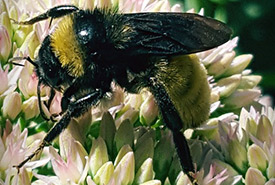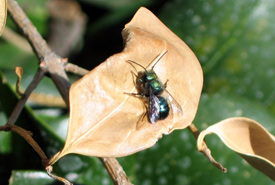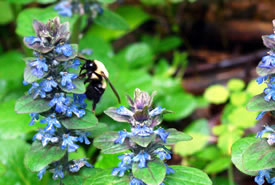Saving the bees: Plants to help our buzzing buddies

American bumble bee (Photo by K.S. Gardener/iNaturalist)
Humans have a very delicate relationship with bees. Despite their importance, many of us fail to understand just how much bees impact our daily lives — and how much we’re putting them at risk.
Canada has over 850 native bee species, and an increasing number are at the risk of extinction. For example, the American bumble bee has decreased in abundance in Canada by a staggering 89 per cent. More than one-third of all crops depend on bees for pollination, including many berries and fruits. Because these gentle creatures play such an active role in pollination, our survival is dependent on their survival.
You can do your part to help encourage bee activity by planting flowers and plants that they love and changing your gardening behaviour ever so slightly. Let’s take a look.
Related blog posts
Say goodbye to insecticides

Blue orchard bee (Photo by Robert Engelhardt)
As convenient as the toxic products can be, especially if you grow your own fruits and veggies, insecticides, herbicides and other chemicals in your garden and on your lawn are more harmful than helpful.
Instead of using pesticides, grow a diversity of plants to attract natural predators, like birds, that help control insect pests without hurting other species, like bees, that are simply going about their daily work. With enough research, you can discover what organic materials (like pepper, onion or garlic) repel certain creepy crawlies without hurting our fuzzy, winged friends.
Let it grow
I like a perfectly manicured lawn as much as the next person, but sometimes it’s good to go wild. Dandelions and clovers are a bee’s best friend, and leaving these to grow in your lawn can help your buzzing visitors thrive. Plus, you’ll have a good excuse to do a little less weeding!
Plant bee-loving flowers

A bee pollinating a plant from the mint family (Photo by NCC)
Although bees are thought to visit up to 15,000 flowers in a single day’s time, there are certain species (and colours!) of flowers that they absolutely adore. First, take the time to research native wildflowers in your area. Not only will they thrive in your climate, but they’ll be sure to attract and support native bees. Flowering herbs are popular, as are flowers with blue and purple blooms.
Vegetables and fruits are also excellent options. And, make sure you plant a wide variety of species so that your yard blooms from early spring until late fall. This will keep both the bees and you surrounded by beautiful flowers.
Bee populations may be in a dire situation, but with these simple steps, we can all pitch in to help their numbers rebound.


